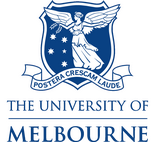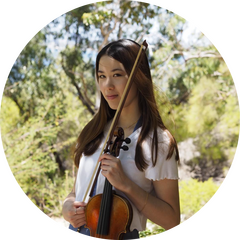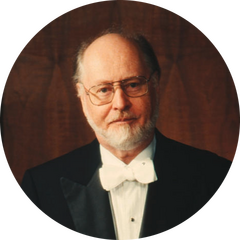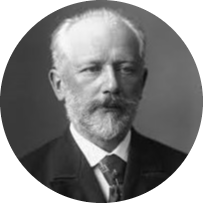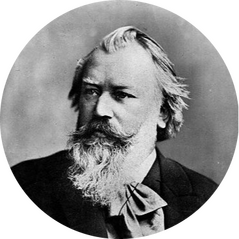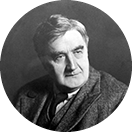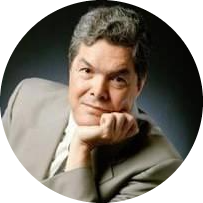MUBSO PRESENTS
CELEBRAT10N
TENTH BIANNUAL CONCERT
PROGRAMWilliams | A Tribute to John WilliamsTchaikovsky | Violin Concerto in D major
I. Allegro moderato
II. Canzonetta: Andante
III. Finale: Allegro vivacissimo- Interval -Brahms | Variations on a Theme by HaydnVaughan Williams | English Folk Song Suite
I. March – Seventeen come Sunday
II. Intermezzo – My Bonny Boy
III. March – Folk Songs from SomersetMárquez | Danzón No. 2

ABOUT MUBSO
The Melbourne University Biomedicine Students' Orchestra, also known as MUBSO, is a symphony orchestra that brings together students from all faculties of the university who share a passion for classical music, orchestra and charity. Founded in 2016, MUBSO is an UMSU affiliated club at the University of Melbourne that offers a rewarding outlet for students to foster their creative talents and serve the community. Since its founding, MUBSO has delivered nine major concerts: Into the Baltic (2017), A Midsemester Night's Dream (2017), Madam Amour (2018), Dreamcatcher (2018), Shine (2019), Voyager (2019), Awakening (2021), Pastorale (2022), and Virtuoso (2022).Celebrat10n is our tenth biannual concert and is a celebration of MUBSO’s achievements throughout the years since our humble beginnings. We are excited to present to you a rich and diverse program of both classical and modern favourites, featuring the works of five composers of different nationalities.Besides major biannual concerts, MUBSO also has a strong medical focus through health-related community concerts, which have included various charity performances over the years at the Royal Melbourne Hospital, Federation Square, and retirement communities. We also hold an annual Camp where we rehearse and bond over a weekend, culminating in a performance in the community on the last day, usually at a retirement home; this has been a rewarding experience for our members. Last year, the establishment of the Chamber Music program has allowed members to form their own groups to play music in, with a chance to showcase their efforts in a Soirée performance last August. Through our musical and social activities throughout the semesters, MUBSO has been able to connect many students with a mutual love of music.Today, MUBSO has grown into more than just an orchestra, but also a close-knit family that thrives on the diversity of its members with hearts for music and charity. Together, we hope to make a meaningful and positive difference in our community, as we endeavour to bring our music to audiences of all ages and backgrounds. For this concert, we are proud to be supporting the Australian Red Cross (more information below), and concert proceeds will be donated towards their mission.We would like to acknowledge the support of Unimelb Faculty of Medicine, Dentistry and Health Sciences, Clubs & Societies, MUBSO alumni, friends, and family. Thank you for joining us in our journey and contributing to this incredible community!---
MUBSO COMMITTEEPRESIDENT
Yuki GohVICE PRESIDENT
Tom LoSECRETARY
Zimo ZhuTREASURER
Jessica ChungPUBLICITY OFFICER
Chen LiEVENTS AND SPONSORSHIP OFFICER
Sophia DowlingLIBRARIAN
Tom AnCATERING MANAGER
Jasmine Ye---
ABOUT AUSTRALIAN RED CROSS
The Australian Red Cross aims to bring people and communities together in times of need and build on community strengths by mobilising the power of humanity.They provide disaster relief, work towards equitable futures for First Nations peoples, help refugees settle into their new communities, and protect humanity in times of war.They have recently been providing emergency relief assistance to communities affected by the Türkiye-Syria earthquakes. Donations have assisted in providing lifesaving support such as health, shelter, and restoring contact with family members.Trusted as a leading humanitarian organisation, Australian Red Cross works to make a genuine difference in the lives of people and communities. MUBSO is proud to support their mission and we would like to thank the audience for your help in doing so.---
MUSICIANS
# Indicates principalVIOLIN I
Celine Ng#
Leon Fei#
Lachlan Chen
Thomas Kwan
Megan Kuo
Matthew Koo
Carl Lu
Georgina He
Stephanie Cho
Melinda Sun
Nicky Lauw
Anshan Arnott-TanVIOLIN II
Vincent Wong#
Haruka Jinguji
Emma Woo
Chen Li
Daniel Lee
Louis Mo
Megan Wang
Ting-Wei Hsu
Freddy Petersen
Anson ZhangVIOLA
Joshua Zhang#
Celeste Wong
Keith Wong
Sophie Han
Victoria Sun
Kameron Lai
Niall Karunaratne
Alice SprungCELLO
Eric Wang#
Elizabeth Seo
Selena Wiesel
Tiffany Pai
Jordan Yu
Wendy Wang
Andrew Wang
Sebastien CroucherDOUBLE BASS
Tom Lo#
Zimo ZhuFLUTE
Kieran Ng#
Janani Ramanan
Shuhan Zeng
Samuel Zong (piccolo)OBOE
Annabel Lam#
Winona LaiCLARINET
Tom An#
Amy Sun
Katherine Wen
Jessica Chung
Dash Park
Hamish MoncktonBASSOON
April Ward#
Seren Adachi
Tom Poynton (contrabassoon)FRENCH HORN
Xin Yi Yu#
Corey East-Bryans
Oscar StocksTRUMPET
Felix Geake-Ransome#
Sophia Dowling#
Oscar Coopes
Emma O’BrienTROMBONE
Joshua Mackie#
Jake Tonkin
Maeve Tan
Hengly MeasTUBA
Finnlay HansenPERCUSSION
Jacqui Wang
Chris Cheng
Brandon Pai
Amelia Liu
Jacq PrestedgePIANO
Mai Nguyen Van
Margaret TangHARP
Jasmine Ye
CONDUCTOR
YUKI GOHYuki is an undergraduate student at the Melbourne Conservatorium of Music majoring in Composition. He has been the student conductor of the Melbourne University Biomedicine Students’ Orchestra (MUBSO) as of 2021 and is also the current Assistant Conductor of the Heidelberg Symphony Orchestra.He commenced his studies in orchestral conducting in 2019 under the tutelage of John Ferguson. That same year, he made his debut at a combined schools orchestra charity concert, a concert organised by students which raised over $4000 for the Skyline Foundation. He has been involved in conducting engagements with other student orchestras ever since. His other mentors include Nicholas Bochner and Christopher Kopke.As a composition student at the Melbourne Conservatorium of Music, Yuki has studied under the tutelage of Timothy Dargaville and Christine McCombe. Notable premieres of his works this past year include that of his orchestral piece After Rain Comes the Rainbow, performed by the Melbourne University Biomedicine Students’ Orchestra, and his percussion piece Time Stop, performed by the Melbourne Conservatorium of Music Percussion Ensemble. He has also had the privilege of workshopping and recording his mixed sextet Where the Quiet Things Are with the Syzygy Ensemble.-----
SOLOIST
CELINE NGFollowing inspiration from the street performers in Austria, Celine began learning violin at 5, shortly before her commencement of the piano at 6. Soon after beginning her violin studies, she was invited to her first solo violin performance at the Perth Concert Hall at 8 years old as part of the Catholic Performing Arts Winners’ Concert. By 11 years old, she had completed Grade 8 on both the violin and piano. Once deciding to focus more on the violin, Celine received her Associate in Music, Australia (AMusA), Licentiate of Trinity College London (LTCL) and Licentiate in Music, Australia (LMusA) by the age of 15.Celine was honoured to have been awarded the Most Outstanding Performer in the North of Perth Music Festival (2017) and the Austa Trophy for Most Outstanding String Performance in the Fremantle Eisteddfod (2018).In 2019, Celine was awarded the Subject Exhibition for Music from the Western Australian Certificate of Education (WACE), receiving an overall mark of 100% for the subject, and was additionally invited to perform at the Performing Arts Perspectives Concert. She has also been a member of WAYO and AYO.For as long as she could remember, Tchaikovsky’s Violin Concerto has been one of Celine’s favourite concertos. She was recently fortunate enough to have had a few masterclasses on this work with Dr Curt Thompson, Head of Strings at the Melbourne Conservatorium of Music.-----
PROGRAM NOTES
JOHN WILLIAMS(1932 – )A Tribute to John Williams, arr. LavenderThe musical voice of American composer John Williams has become one that is instantly recognisable among audiences, listeners and musicians alike. He has scored for over one hundred films, including all nine Star Wars films, Schindler’s List, E.T. the Extra-Terrestrial, Jaws, Jurassic Park, Saving Private Ryan, and Superman. In addition to his film scores, Williams has also written numerous concert works, including a symphony, several concertos and chamber works.This five-minute medley, featuring six memorable film themes – Star Wars, Jaws, Superman, Harry Potter, Raiders March, and E.T. – was arranged by Paul Lavender for the 2004 Honors Gala Concert at the Kennedy Center Opera House. Since 1978, the Kennedy Center Honors in Washington D.C. has united the arts, entertainment, and political communities for gala weekends of festivities and performances in honour and recognition of America’s most prestigious artists. This medley of Williams’ music was performed then by the United States Marine Band under the baton of Leonard Slatkin, alongside a performance of the theme from Schindler’s List played by violinist Itzahk Perlman. May the performance of this medley remind audiences of the remarkable legacy of a modern-day composer who will continue to inspire and enrich the generations to come.-----
PYOTR ILYICH TCHAIKOVSKY(1840 – 1893)Violin Concerto in D majorI. Allegro moderato
II. Canzonetta: Andante
III. Finale: Allegro vivacissimoTchaikovsky’s Violin Concerto is considered to be amongst the most beautiful works of Romantic music, with hints of heroism, soaring lyrical melodies and Russian folk music. Yet, hidden beneath its guise as a virtuosic showpiece, Tchaikovsky subtly reveals his vulnerability and inner turmoil, through the intense sweeping emotions throughout.Despite its success in the modern century, Tchaikovsky’s Violin Concerto had a rocky start to its journey. Although dedicated to violinist Leopold Auer, the predecessor of violinists Mischa Elman and Jascha Heifetz, he refused to premier this concerto. Many sources have proposed that this was due to Auer’s regard for the concerto as “impossible to play”. Auer himself told The Musical Courier (1912) that “on closer acquaintance with the composition, I had regretted that the great composer had not shown it to me before committing it to print…”. He did eventually perform the work however with “some slight alterations in the passages of the solo part”.Despite this delayed performance, the concerto was instead premiered by Adolf Brodsky in 1881. At the time, he was the concertmaster of the New York Symphony and later served as the Director of the Royal College of Music. Brodsky performed the work with Hans Richter and the Vienna Philharmonic, however due to inadequate rehearsal time, the orchestra was only able play the accompaniment at a pianissimo dynamic. Hence, despite an inspiring performance by Brodsky, the music was not well received. In fact, Eduard Hanslick, a Viennese critic, described the concerto as “music that stinks in the ear”, whereby “the violin…is beaten black and blue”.To say such comments would be controversial in the modern day would be an understatement, as Tchaikovsky’s Violin Concerto is now known for its effervescence, a masterpiece which truly illustrates Tchaikovsky’s melodic gift.The first movement, Allegro moderato, creeps in with a soft introduction entrusted to the first violinists. Soon, the solo violin enters with the main theme, which sings over a quiet string accompaniment. This subject is gradually built upon, becoming more elaborate, this expansion dramatised by the likewise build in coloration and strength of the orchestral accompaniment. There are two themes that comprise the exposition, the second being much more emotional, with a more melancholy, contemplative melody. The development soon pursues, presenting variations on the main theme, culminating in the fiery cadenza, rich with virtuosic decorations and tricks. This is followed by the recapitulation, before the orchestra joins in with a more involved and extravagant coda to finish the movement.Interestingly, Tchaikovsky originally wrote the Méditation that opens his now Souvenir d’un lieu cher as the second movement for this concerto, however both he and his audience had felt that it wasn’t fitting for the concerto. Hence, Tchaikovsky wrote the Canzonetta as a replacement – supposedly in just one day! The Canzonetta is a sweet balance of both intimacy and tenderness, with a poignant melody soaring over a delicate orchestral accompaniment.The Finale is an exciting movement to finish, opening with a triumphant orchestral introduction, leading into a folk-like Rondo melody, resemblant of many of Tchaikovsky’s Russian ballets and dances. It opens with a rigorous orchestral introduction which serves as a launchpad for the soloist’s first cadenza. Tchaikovsky exploits the agility and acrobatic capacities of the violin, incorporating a multitude of brilliant scales and leaps into the solo. The heroic theme is thrown back and forth between the orchestra and soloist, as they speed towards grand dynamic swells, with an explosive D major chord to finish.-----
JOHANNES BRAHMS(1833 – 1897)Variations on a Theme by Haydn, Op. 56aBased on the “St Anthony Chorale” attributed to Joseph Haydn (1732 – 1809) – although this attribution is generally thought to be incorrect – Brahms initially scored his Variations on a Theme by Haydn for piano duo during the summer of 1873, before orchestrating the work shortly after.This monumental work is a set of eight variations on the St Anthony Chorale and is a testament to Brahms’ mastery of intricate counterpoint, motivic development and form. Each variation has its own unique and identifiable character. The theme is comprised of two five-bar phrases, as opposed to the usual four-bar phrase, introduced by the oboes and bassoons playing in harmony. A brief description of each of the variations is as follows:Variation 1 (Poco piu animato): features an expansive melodic line in the upper strings which is interweaved polyrhythmically with its fluid countermelody in the lower strings. Bell-like unison octaves in the winds and brass feature constantly in the background.Variation 2 (Piu vivace): contains two contrasting characters. A loud, proclamatory opening gesture alternates with a more graceful and playful melodic line. The dotted rhythm of the theme is used as the basis of this variation.Variation 3 (Con moto): features a lyrical melody in perpetual quaver motion above a countermelody of identical smoothness, evoking a flowing, continuous river. Fluidity is enhanced with the introduction of moving semiquavers.Variation 4 (Andante con moto): cast in the parallel minor, this variation features a rising and falling melody in stepwise motion above a flowing semiquaver countermelody. The variation has a wistful and sentimental character.Variation 5 (Vivace): light, staccato quavers feature in this variation in a compound 6/8 time, evocative of a scherzo. Hemiola rhythms lend both complexity and interest.Variation 6 (Vivace): a steady, hunting-style march characterised by fanfare-like gestures.Variation 7 (Grazioso): the most heavenly variation features in a lilting siciliano, spacious and warm in sound. Flute and violas introduce the melody in a unique instrumental pairing.Variation 8 (Presto non troppo): the shortest and quietest variation is also the most sinister-sounding. Cast in the minor mode, delicate woodwind lines are imposed above hushed, muted strings, evoking a fast-moving storm cloud which passes and vanishes unexpectedly.Finale (Andante): the finale is an extended passacaglia featuring the five-bar section of the original theme as its repeating unit. Beginning with a hymn-like statement, the music gradually builds in complexity and texture as it swirls through a variety of moods and musical ideas, including a more foreboding passage in the minor mode. The unexpected entry of a triangle marks the beginning of a build-up towards a climactic restatement of the original chorale theme, in full orchestral force, and the piece concludes in a splendid festivity.-----
RALPH VAUGHAN WILLIAMS(1872 – 1958)English Folk Song Suite, arr. JacobI. March – Seventeen come Sunday
II. Intermezzo – My Bonny Boy
III. March – Folk Songs from SomersetVaughan Williams’ English Folk Song Suite was originally composed in 1923 for wind band, around the time when European composers such as Bartók, Grainger and Vaughan Williams himself had an interest in utilising folk music as the foundation for their compositions. The suite was then orchestrated by Gordon Jacob (1895 – 1984) the following year in 1924.Although in three movements, the suite weaves together a total of nine folk songs from the British Isles. The suite initially contained a fourth movement – Sea Songs – but was later removed from the work after its premiere.The first movement, “Seventeen Come Sunday,” opens with the eponymous folk song in a British march style. The movement is structured in an ABCBA arch form, featuring two other folk songs – the lyrical Pretty Caroline sung by solo clarinet and a full-bodied, marcato orchestration of Dives and Lazurus.The poignant, haunting second movement opens with a song about unrequited love – My Bonny Boy – first introduced by solo oboe before taken on by the lower strings in a more expressive voice. The movement suddenly transitions into a swirling and spirited arrangement of Green Bushes before reverting to the first theme and concluding on a sentimental note.The third movement contains four folk songs, each occurring in succession, in a march style. It opens with the jaunty Blow Away the Morning Dew, before it is answered by High Germany, a war ballad where a soldier attempts to entice a fair maiden. The trio section features two more folk songs, The Tree so High and John Barleycorn. The first two melodies repeat da capo, before the suite closes with a strong, final tonic note.-----
ARTURO MÁRQUEZ(1950 – )Danzón No. 2“Danzón 2 ... endeavors to get as close as possible to the dance, to its nostalgic melodies, to its wild rhythms, and although it violates its intimacy, its form and its harmonic language, it is a very personal way of paying my respects and expressing my emotions towards truly popular music.” (Arturo Márquez)Márquez was born in Mexico and spent his early life exposed to a variety of traditional music styles, all of which shaped him to be the composer he is today. He incorporates the styles and forms of Mexican music into his orchestral works, the most famous of which are the danzónes written in the 1990s.The Danzón is a formal ballroom dance which had its origins in Cuba, but has become popularised in Mexico and firmly linked to its cultural and urban landscape. Danzón No. 2 was commissioned by the National Autonomous University of Mexico in 1994, and Márquez dedicated it to his daughter Lily.The work is unified by its main theme which is first introduced as a legato clarinet solo above pizzicato strings, a relaxed piano accompaniment and the steady rhythm of the claves. Much of the appeal in this work stems from its dynamic changes in mood, tempo and orchestration as the main theme recurs throughout the piece in a variety of mediums. It can appear as melancholic, passionate, frenzied, seductive and euphoric. Various instrumental sections and solos are featured, and the piece thus showcases a diverse orchestral palette of sounds and timbres. From the intimacy of the violin solo in the lyrical middle section to the cacophonous call-and-response between the winds and brass in the more vigourous sections, this piece takes the listener on a thrilling ride of emotions, a flurry of energy that concludes with a smashing orchestral crescendo.-----Program notes written by Yuki Goh and Celine Ng.We hope you enjoy the concert!-----
